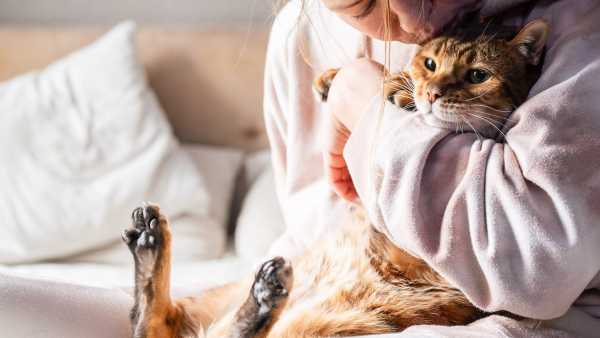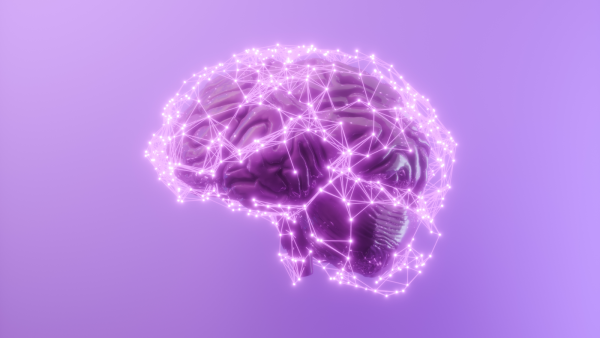
Do they produce oxytocin in their brains? (Image credit: Zhenny-zhenny via Shutterstock)
Cats may have a reputation for being independent creatures, but new research shows we have a unique bond with them based on brain chemistry.
The key chemical involved in this process is oxytocin, often called the love hormone. It's the same neurochemical released when a mother rocks her baby or when friends hug, strengthening trust and affection. Research shows that oxytocin is also important for the bond between cats and humans.
You may like
-

Are cats the only animals that purr?
-

Why do cats hate water?
-

Why do cats love concrete slabs?
Oxytocin also has a calming effect on humans and animals because it suppresses the stress hormone cortisol and activates the parasympathetic nervous system (the rest and digestion system), helping the body relax.
Scientists have long known that friendly interactions trigger the release of oxytocin in both dogs and their owners, creating a feedback loop and strengthening the bond. However, until recently, little was known about its effects on cats.
Cats display affection more subtly. However, their owners often report the same warm feelings of companionship and stress relief as dog owners, and research increasingly supports these reports. For example, Japanese scientists reported in 2021 that short petting sessions with cats increased oxytocin levels in many owners.
In this study, women interacted with their cats for several minutes while scientists measured their owners' hormone levels. The results showed that friendly contact (petting the cat, speaking in a soothing tone) was associated with increased oxytocin levels in the humans' saliva compared to a period of quiet rest without a cat.
Many people find petting a purring cat calming, but research shows that this isn't just due to the soft fur. The act of petting and even the sound of a purr can trigger the release of oxytocin in the brain. One 2002 study found that the release of oxytocin from gentle contact with a cat helps reduce cortisol (the stress hormone), which in turn can reduce blood pressure and even pain.

Cuddling a cat can help suppress the stress hormone cortisol. When do cats and humans release oxytocin?
Research has identified specific moments that trigger the release of this hormone in interspecies friendships. For cats, the primary trigger appears to be light physical contact.
A February 2025 study found that when owners calmly pet, cuddle, or rock their cats, their oxytocin levels tended to rise, as did the cats'—unless the interaction was forced on the animal.
You may like
-

Are cats the only animals that purr?
-

Why do cats hate water?
-

Why do cats love concrete slabs?
Researchers monitored oxytocin levels in cats for 15 minutes while they played and cuddled with their owner. Securely attached cats that initiated contact, such as sitting on their laps or pushing, experienced a surge in oxytocin. The more time they spent with their owners, the greater this surge.
What about less affectionate cats? The same study noted differences in behavior patterns in cats with more anxious or aloof attachment styles. Avoidant cats (those who kept their distance) showed no significant changes in oxytocin levels, while anxious cats (constantly seeking their owner but easily upset by interactions) had high oxytocin levels to begin with.
Cats with avoidant and anxious behaviors have been found to have decreased oxytocin levels after forced cuddles. When interactions are based on respect for the cat's comfort, oxytocin is produced in high quantities, but when a cat feels cornered, the bonding hormone is elusive.
Perhaps humans could learn from their feline friends about managing attachment styles. The key to establishing a bond with a cat is understanding their communication patterns.
Unlike dogs, cats don't require prolonged eye contact to establish a bond. Instead, they use more subtle signals. The most well-known of these is a slow blink. This is a feline smile, signaling security and trust.
Purring also plays an important role in bonding with people. A cat's low-frequency purr is associated not only with therapeutic effects for the cats themselves but also with a calming effect on humans. Listening to a purr can reduce heart rate and blood pressure; oxytocin contributes to these effects.
Bonding with a cat, reinforced by small bursts of oxytocin from daily interaction, can serve as a buffer against anxiety and depression, and in some cases provide comfort on par with human social support.
Are cats just less loving than dogs?
Indeed, studies typically demonstrate a stronger oxytocin response when dogs and humans interact. In one widely discussed 2016 experiment, scientists measured oxytocin levels in pets and their owners before and after ten minutes of play. Dogs' oxytocin levels increased by an average of 57% after play, while cats' oxytocin levels increased by approximately 12%.
In humans, oxytocin levels rise during meaningful social interactions. Research shows that contact with a loved one elicits a stronger oxytocin response than contact with strangers. Therefore, a dog's joyful greeting is akin to the excitement of meeting a child or partner.
Dogs, as pack animals domesticated for constant human interaction, almost inherently seek eye contact, affection, and approval from us—behaviors that stimulate oxytocin production in both parties. Cats, on the other hand, evolved from more solitary hunters who didn't require overt social gestures to survive. Therefore, they may not exhibit oxytocin-producing behaviors as frequently or regularly. Instead, cats may reserve their oxytocin-producing behaviors for times when they truly feel safe.
RELATED STORIES
— Cats recognize familiar scents and can identify strangers by the scent of their armpits and toes.
— Cats may have been domesticated much later than we thought, with earlier members of the cat family being eaten or made into clothing.
— Research has shown that cats are better at word associations than human children.
A cat's trust doesn't come automatically; it must be earned. But once established, it's reinforced by the same chemical that bonds people with parents, partners, and friends.
So the next time your cat slowly blinks while sitting on the other end of the couch or climbs into your lap to purr, know that something invisible is happening: oxytocin levels are rising in both your brains, building trust and relieving the stress of everyday life. Cats, in their own way, are tapping into the ancient biology of love.
This edited article is republished from The Conversation under a Creative Commons license. Read the original article.

Laura Elin Pigott, Senior Lecturer in Neuroscience and Neurorehabilitation, Course Director at the College of Health and Life Sciences, London South Bank University
Laura Elin Pigott is a neuroscientist and Senior Lecturer at London South Bank University, where she leads courses in neuroscience and neurophysiology and implements educational initiatives. Her research covers neuroimaging, glioma progression, and machine learning in cancer diagnostics, with recent work focusing on cognitive neuroscience and brain development. She is also actively promoting gender equality in STEM, collaborating with UN Women UK and participating in initiatives such as Frontiers Women in Neurology/Radiology.
You must verify your public display name before commenting.
Please log out and log back in. You will then be asked to enter a display name.
Exit Read more

Are cats the only animals that purr?

Why do cats hate water?

Why do cats love concrete slabs?

Why do cats and dogs eat grass?

Wild killer whales offer food to people. Are they trying to befriend us or manipulate us?

A scientist's cat has once again helped discover a rare virus.
The last thing in memory

If tiny lab-grown “brains” became conscious, could they be experimented on?

Tiny lab-grown 'brains' can gain consciousness and feel pain—and we're not ready for that.

A map of 600,000 brain cells rewrites the textbook on how the brain makes decisions.

'Mini-brains' reveal secrets of key brain cell formation in the womb

A new brain implant can decipher a person's 'inner monologue'.

Is it possible to dream during the slow wave sleep phase?
Latest news

A new chip is bringing quantum internet closer, enabling the transmission of quantum signals over real fiber optic cables.

The documentary “Cleopatra's Last Secret” tells the story of hundreds of coins and port wine found in Egypt. But does this mean Cleopatra was buried there?

A 1,600-year-old hoard of coins found in a complex tunnel system beneath Galilee dates back to the last Jewish revolt against the Romans.

Who's Eligible for the COVID Vaccine This Year? Everything You Need to Know

'Completely inexplicable': James Webb Space Telescope discovers strange 'dark beads' in Saturn's atmosphere

'Shocking': Black hole discovered growing 2.4 times faster than theoretical limit
LATEST ARTICLES

1Huge golf ball-sized hail leaves 125-mile scar on Canadian landscape
Live Science magazine is part of Future US Inc., an international media group and leading digital publisher. Visit our corporate website.
- About Us
- Contact Future experts
- Terms and Conditions
- Privacy Policy
- Cookie Policy
- Accessibility Statement
- Advertise with us
- Web notifications
- Career
- Editorial standards
- How to present history to us
© Future US, Inc. Full 7th Floor, 130 West 42nd Street, New York, NY 10036.
var dfp_config = { “site_platform”: “vanilla”, “keywords”: “type-crosspost,exclude-from-syndication,type-news-explainer,serversidehawk,videoarticle,van-enable-adviser-
Sourse: www.livescience.com





